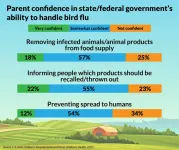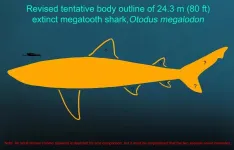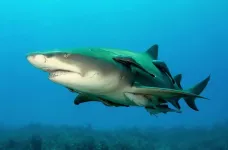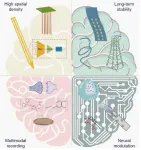(Press-News.org) With soaring egg prices and ongoing bird flu headlines, many parents are uncertain about the risks and facts surrounding the virus, a national poll suggests.
Most parents say they don’t know if there have been cases of bird flu in their state, and less than half feel that they are able to find accurate and current information about it, according to the University of Michigan Health C.S. Mott Children’s Hospital National Poll on Children’s health.
“Many parents may hear about bird flu in the news but don’t feel well-informed or know if they should be taking action to protect their families,” said Mott Poll Co-Director Sarah Clark, M.P.H.
“This report highlights the challenge for parents to keep track of an emerging health situation and understand its potential threat to their child’s health.”
Bird flu, or H5N1, which was reported in the U.S. in March 2024, is widespread in wild birds worldwide that transmit infection to poultry and dairy cows. H5N1 infections in humans have so far been limited to those who come in close contact with infected animals, including U.S. farmworkers.
While the current public health risk has been deemed low, with no evidence of transmission from human to human, the outbreak has increased public concern about the potential for broader transmission.
Previous outbreaks of H5N1, including one in 2003-2005, highlight this possibility.
Steps parents believe protect families from avian flu
While one in five parents say the media is making too big a deal about the virus, two in five wish the government was doing more to prevent an outbreak, according to the nationally representative report based on responses from 2,021 parents of children aged 18 and under.
Another one in three parents have taken action to protect their family against bird flu, the poll suggests, but not all strategies are evidence-based.
A little less than a quarter of parents say they’re being more careful about general hygiene while 13% are more cautious handling eggs, chicken and beef. Another 12% are avoiding contact with birds and other wild animals while 7% are eating less eggs, chicken, and beef.
“Some parents indicated they have cut back on eating poultry products like eggs and chicken,” Clark said. “However, as long as eggs and meat are fully cooked, there’s no evidence that bird flu is spread through these products.”
Among the 68% of parents who haven’t taken preventive actions, their main reasons are that they already have good hygiene practices, don’t know the recommendations or don’t feel at risk.
Confidence in containing the virus
Nearly half of parents rate themselves as very concerned about the rising cost of eggs and meat associated with bird flu, and over a quarter are very concerned about bird flu spreading from animals to humans or humans to humans.
A third of parents, however, weren’t confident in the government’s ability to contain bird flu.
Less than 20% of parents expressed high confidence in the state or federal government’s ability to remove infected animals or animal products from the food supply while 22% are very confident the government will be able to inform people about which products should be recalled or thrown away.
“There appears to be a gap in public confidence when it comes to the national response to bird flu,” Clark said. “Misinformation and uncertainty can fuel anxiety, so it’s critical that health officials communicate transparently about containment efforts and food safety to reassure families.”
Keeping up with evolving information can be challenging with parents polled saying their main sources are news reports, followed by social media and internet searches. Fewer got information from family or friends, a government agency or healthcare providers
Reinforcing preventive health measures
Bird flu is an influenza A virus that produces a gastrointestinal infection, causing death from diarrhea and respiratory distress. The version currently circulating in the U.S., known as H5N1 2.3.4.4b, is highly lethal
Because H5N1 is very contagious, it’s become standard practice to cull the entire flock or herd to prevent the spread once it’s discovered in an animal. Millions of chickens have been culled as a preventive measure, contributing to the increased price of eggs.
While the risks of bird flu are greatest for individuals who work with farm animals and their families, Clark says, the situation presents an opportunity for parents to reinforce the principles of good hygiene with their children.
Children should be cautioned to avoid dead animals, she says, and try to avoid animal droppings, which can be hard to detect in yards or sandboxes.
“Parents should teach their child to keep their hands away from their face and remind them to wash their hands with soap and water after touching birds and other animals at a petting zoo or a neighbor’s backyard chicken coop,” Clark said.
Clark recommends that parents practice good hygiene with food, such as cooking eggs and meat to recommended temperatures, and choosing milk and other dairy products that are pasteurized to kill germs.
END
Less than half of parents think they have accurate information about bird flu
National Poll: 2 in 5 parents wish the government was doing more to prevent a bird flu outbreak; 1 in 3 have taken action to protect their family against it
2025-03-10
ELSE PRESS RELEASES FROM THIS DATE:
Common approaches for assessing business impact on biodiversity are powerful, but often insufficient for strategy design
2025-03-10
A University of Oxford study has determined that the widely used tools available to businesses for assessing their biodiversity impacts depend on broad assumptions and can have large uncertainties that are poorly understood or communicated. If used appropriately, they can be powerful tools to help guide effective action to address biodiversity loss – but if not, they can lead to misguided effort and can be insufficient for robust biodiversity strategy design.
Businesses across a range of industries and sectors are under growing pressure to develop biodiversity strategies that not only minimise their negative impacts but ...
Can a joke make science more trustworthy?
2025-03-10
Politicians learned this lesson a long time ago: a well-placed joke is a valuable tool for capturing public attention and building trust. Scientists, however, are much more reluctant to use humor when engaging in science communication. They may fear that a lighthearted approach could make them seem less authoritative and, consequently, make scientific findings appear less credible.
The good news, however, is that science itself seems to contradict this assumption. A new study led by Alexandra Lynn Frank, a ...
Hiring strategies
2025-03-10
Krapivsky drew inspiration from the famous “secretary problem” or “optimal marriage problem”. In one of its many versions, a princess must choose her future husband from a pool of 100 candidates at a grand reception. However, strict rules apply: she may meet only one suitor at a time and has limited time to get to know him. At the end of each encounter, she must decide immediately whether to accept or reject the suitor. She cannot revisit previous candidates, nor can she ask any of them to wait while she considers others. How can the princess hope to make the best choice?
The secret lies in a number: 37, to be precise (raise your hand if you ...
Growing consumption of the American eel may lead to it being critically endangered like its European counterpart
2025-03-10
High demand for eel combined with decline in stock have resulted in soaring prices for this food item, which in many cultures, is considered a delicacy. This has fuelled a concern globally as the prized food item is now being illegally traded from Europe to Asia.
Current research has focused on the critically endangered Anguilla anguilla, commonly known as the European eel. While its export outside the European Union is tightly regulated, large quantities of A. anguilla juveniles continue to be smuggled ...
KIST develops high-performance sensor based on two-dimensional semiconductor
2025-03-10
Next-generation imaging technology is rapidly expanding beyond smartphones into intelligent devices, robotics, extended reality (XR) devices, healthcare, CCTV, and various other industries. At the core of these technological advances are highly efficient, ultra-compact image sensors that convert light signals into electrical signals. Image sensors capture and process visual information from objects and environments, enabling precise reconstruction of their shape, size, and spatial position.
Currently, commercial image sensors are primarily based on silicon semiconductors. ...
New study links sleep debt and night shifts to increased infection risk among nurses
2025-03-10
A new study examining the effects of sleep patterns and shift work on the immune system has found that sleep debt and night shifts increase the risk of several common infections in nurses.
Modern society relies on shift work, which requires employees to work outside of traditional hours. While essential in sectors such as healthcare, growing evidence suggests that these work patterns may negatively impact worker’s health.
This study, which analysed self-reported data from 1,335 Norwegian nurses, found that shift work – particularly night shifts – was associated with a higher risk of several infections, including the ...
Megalodon’s body size and form uncover why certain aquatic vertebrates can achieve gigantism
2025-03-09
CHICAGO — A new scientific study provides many new insights into the biology of the prehistoric gigantic shark, Megalodon or megatooth shark, which lived nearly worldwide 15-3.6 million years ago. Paleobiology professor Kenshu Shimada of DePaul University led the study along with 28 other shark, fossil, and vertebrate anatomy experts around the globe. Findings from the study will be published in the journal “Palaeontologia Electronica.”
Formally called Otodus megalodon, it is primarily known only from its serrated teeth, vertebrae, ...
A longer, sleeker super predator: Megalodon’s true form
2025-03-09
The megalodon has long been imagined as an enormous great white shark, but new research suggests that perception is all wrong. The study finds the prehistoric hunter had a much longer body—closer in shape to a lemon shark or even a large whale.
The study team, which included researchers from University of California, Riverside and across the globe, used a novel approach to estimate the shark’s total body length, moving beyond traditional methods that rely primarily on tooth size. By examining megalodon’s vertebral column and comparing ...
Walking, moving more may lower risk of cardiovascular death for women with cancer history
2025-03-09
Research Highlights:
Increased physical activity including taking more daily steps was linked to a lower risk of death from cardiovascular disease among postmenopausal women with a history of cancer.
The study found that engaging in one hour per day of moderate to vigorous physical activity reduced participants’ risk of death from any cause by 40% and risk of death from cardiovascular disease by 60%.
Each additional 2,500 steps per day for a participant was associated with a 34% reduction in risk of death from cardiovascular disease.
Note: The study featured in this news release is a research abstract. Abstracts presented ...
Intracortical neural interfaces: Advancing technologies for freely moving animals
2025-03-09
A recent study published in Engineering delves into the latest progress in intracortical neural interface technologies for freely moving animals. These interfaces, which establish a connection between the nervous system and external devices, have the potential to revolutionize neuroscience research and clinical medicine.
The researchers, led by Xinxia Cai, Zhaojie Xu and Yirong Wu, analyzed four key technological directions for ideal implantable neural interface devices: higher spatial density, improved biocompatibility, enhanced multimodal detection of electrical/neurotransmitter signals, and more effective neural modulation.
In terms of high spatial density, microelectrode ...
LAST 30 PRESS RELEASES:
Fame itself may be critical factor in shortening singers’ lives
Daily coffee drinking may slow biological ageing of people with major mental illness
New highly efficient material turns motion into power – without toxic lead
The DEVILS in the details: New research reveals how the cosmic landscape impacts the galaxy lifecycle
After nearly 100 years, scientists may have detected dark matter
Gender imbalance hinders equitable environmental governance, say UN scientists
Six University of Tennessee faculty among world’s most highly cited researchers
A type of immune cell could hold a key to preventing scar tissue buildup in wounds
Mountains as water towers: New research highlights warming differences between high and low elevations
University of Tennessee secures $1 million NSF grant to build semiconductor workforce pipeline
Biochar shows powerful potential to build cleaner and more sustainable cities worldwide
UT Health San Antonio leads $4 million study on glucagon hormone’s role in diabetes, obesity
65-year-old framework challenged by modern research
AI tool helps visually impaired users ‘feel’ where objects are in real time
Collaborating minds think alike, processing information in similar ways in a shared task
Routine first trimester ultrasounds lead to earlier detection of fetal anomalies
Royal recognition for university’s dementia work
It’s a bird, it’s a drone, it’s both: AI tech monitors turkey behavior
Bormioli Luigi renews LionGlass deal with Penn State after successful trial run
Are developers prepared to control super-intelligent AI?
A step toward practical photonic quantum neural networks
Study identifies target for disease hyper progression after immunotherapy in kidney cancer
Concordia researchers identify key marker linking coronary artery disease to cognitive decline
HER2-targeted therapy shows promising results in rare bile duct cancers
Metabolic roots of memory loss
Clinical outcomes and in-hospital mortality rate following heart valve replacements at a tertiary-care hospital
Too sick to socialize: How the brain and immune system promote staying in bed
Seal milk more refined than breast milk
Veterans with cardiometabolic conditions face significant risk of dying during extreme heat events
How plants search for nutrients
[Press-News.org] Less than half of parents think they have accurate information about bird fluNational Poll: 2 in 5 parents wish the government was doing more to prevent a bird flu outbreak; 1 in 3 have taken action to protect their family against it





